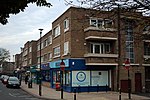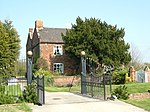Castle Vale is a housing estate located between Erdington, Minworth and Castle Bromwich. Currently Castle Vale makes up the Castle Vale Ward of Birmingham City Council which is part of Erdington constituency (having previously been part of Hodge Hill constituency until recent times), 6 miles (9 km) northeast of Birmingham city centre in England. The area has an approximate population of 10,000 people and has a distinctly modern residential character stemming from its history as a postwar overspill estate.
The area was originally known as Berwood, from the Saxon 'Bearu' meaning 'the woods'. Historically being a boggy and wooded area, the area remained undeveloped for most of its history until the deforestation practices of Edward Darcy in the 17th century and the construction of the Birmingham and Fazeley Canal in the 18th century. In the 20th century, the land became the site for the first aeroplane take-off in Birmingham which led to a long aviation history being associated with the area. Castle Bromwich Aerodrome was established on the site and operated from 1914 to 1960, being a major airfield in both World Wars and also having industrial importance as the testing facility for locally manufactured aeroplanes and the location for the British Industries Fair. Despite being steeped in aviation history, Castle Vale became infamous from the 1970s onwards as a large scale example of a failed postwar overspill estate, which suffered from poor construction and maintenance, social deprivation and high levels of crime. The area became the focus of a targeted regeneration initiative, led by the Castle Vale Housing Action Trust (CVHAT) from 1993 to 2005, where the estate witnessed the demolition of many of its housing stock and facilities, the refurbishment of remaining properties, and the construction of new housing and facilities along with the remodelling of the estate, funded both privately and publicly.







